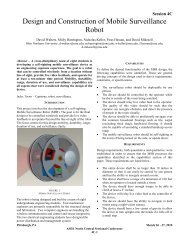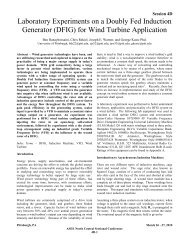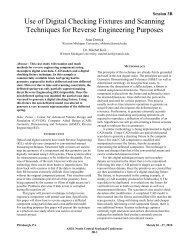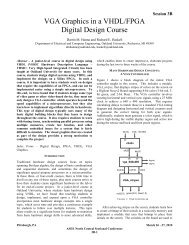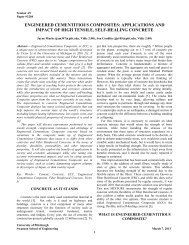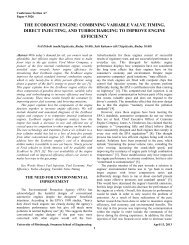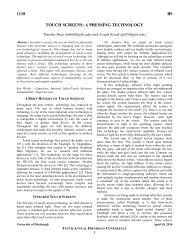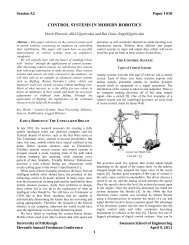ELECTROMAGNETIC & EDDY CURRENT BRAKING SYSTEMS
ELECTROMAGNETIC & EDDY CURRENT BRAKING SYSTEMS
ELECTROMAGNETIC & EDDY CURRENT BRAKING SYSTEMS
You also want an ePaper? Increase the reach of your titles
YUMPU automatically turns print PDFs into web optimized ePapers that Google loves.
Andrew Sponsler<br />
Sean Kurtz<br />
permanent magnet system is unable to hold a body in<br />
place. ECB are excellent at slowing down high speed<br />
moving objects, but just have not been sufficiently<br />
developed to work at lower speeds. This is the main reason<br />
why ECB have not been used in cars, by assumption. The<br />
concept is promising, but there has not been enough research<br />
performed on the subject to find a way to apply the system<br />
to smaller moving bodies or bodies moving at low velocities.<br />
Another significant disadvantage to eddy current brakes<br />
is their studied interference with other signaling and electric<br />
parts of certain applications. Since this system relies heavily<br />
on magnetism, the fields in place by the brakes can alter<br />
other signaling processes. A study involving high-speed<br />
trains showed that several of the signaling grids were<br />
experiencing interference caused by the ECB system’s<br />
generated magnetic field, even while the ECB system was in<br />
the off position [8]. The permanent magnets involved in<br />
ECB may potentially pose hazards to sensitive medical<br />
equipment, such as pacemakers, as well as many other<br />
electronic devices that would be brought within a certain<br />
proximity to the car. This issue needs to be fixed before<br />
ECB can be used commercially.<br />
<strong>CURRENT</strong> USES OF EBS AND ECB<br />
Electromagnetism is not simply a way of the future for<br />
automobiles. The concepts may be applied to any technology<br />
with moving parts. Electromagnetic brakes in particular are<br />
already commonly used in industries such as production and<br />
transportation.<br />
• Copiers and printers<br />
• Packaging machinery<br />
• Conveyors<br />
• Textile machinery<br />
• Rollercoasters<br />
• High speed locomotives<br />
List of devices with EBS<br />
This list of devices represents the diversity of the utility<br />
of mechanically applied electricity. This list is limited and<br />
does not involve all systems currently in place.<br />
Sustainability<br />
A natural question posed of any aspiring technology is,<br />
“Is it sustainable?” The heart of this question is financial in<br />
nature – any investor would want to know if the advantages<br />
can quantifiably outweigh the disadvantages. Would an eddy<br />
current brake system viably afford a powerful retarding<br />
system, while functioning in a way so that energy or other<br />
material is not significantly depleted or wasted? The answer<br />
lies in practical examination of the torque applicator within<br />
the system. In ECB the torque is applied without physically<br />
contacting the disc wheel, applying torque solely with a<br />
magnetic field. Since there is no mechanical contact, there is<br />
no part to be worn down over time as quickly as the<br />
frictional system equivalent: the brake pad. The elimination<br />
of the brake pad in ECB limits the amount of material<br />
depleted by enabling the brakes. Also, the use of brake pads<br />
emits thermal energy from direct contact with the brake disc.<br />
The brake disc over time can crack from continuous braking.<br />
This part is another major component that needs to be<br />
replaced in traditional frictional systems that is eliminated<br />
by the use of an eddy current brake.<br />
The sustainable effect of switching to a system without<br />
brake pads and discs is clearly seen: first, less material is<br />
released as pollution and, second, there is no need to replace<br />
any brake pads and discs during the life of the system. In<br />
traditional friction-based brake systems, the application of<br />
the brake pad onto the brake disc generates the mechanical<br />
torque required to stop rotation. In the course of application,<br />
the brake pads are worn away and the material that is worn<br />
off must be deposited elsewhere. The dust given off of the<br />
brake pads is given off through the wheel well and released<br />
into the atmosphere. While the volume of material given off<br />
as dust due to a single vehicle may seem inconsequential, the<br />
net result of the pollution of all vehicular brake systems may<br />
adversely affect the environment. An advantage of<br />
eliminating the brake pads would be that the pollution due to<br />
wear and tear of the brake pads would also be eliminated. Of<br />
course, in a system without brake pads and discs, no brake<br />
pads or discs would need to be replaced. Therefore in the<br />
long-term the cost of maintenance is low compared to<br />
friction brakes since there are no parts that require as<br />
frequent replacement.<br />
Finances take a significant cut when eddy current brakes<br />
are implemented. The initial costs of ECB are more<br />
expensive than traditional systems. Though, in the long run,<br />
this new system pays for itself. In an estimated period of<br />
seven years, expenses for frictional systems surpass the ECB<br />
system. So, in the normal life span of a car, ECB would<br />
save the owner expenses on brakes past seven years. Also,<br />
the owner would not have to take the car in to exchange<br />
brake pads and to inspect brake discs every year, depending<br />
on the driver. The use of fuel can also be cut when installed<br />
in the car. ECB can use power from either the cars battery<br />
or another electrical power source. The application of this<br />
system to an electric car would be able to advance green<br />
technology already in place. Since ECB uses a magnetic<br />
field, energy is conserved compared to frictional systems<br />
that convert all of their energy to thermal heat. This thermal<br />
heat is then dissipated into the air surrounding the brake, in<br />
the frictional system. Thus, eddy current brakes do not give<br />
off excess energy. The use of eddy current brakes in cars is<br />
economically sound for the consumer in the long run and has<br />
the potential to outlive the rest of the car. This braking<br />
system does not develop new extra expenditures to be made<br />
University of Pittsburgh<br />
Swanson School of Engineering April 13, 2013<br />
6




